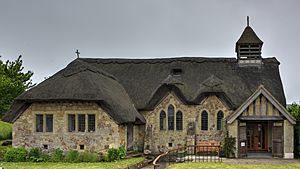St Agnes' Church, Freshwater facts for kids
Quick facts for kids St Agnes' Church, Freshwater |
|
|---|---|
 |
|
| 50°40′24″N 01°31′03″W / 50.67333°N 1.51750°W | |
| Denomination | Church of England |
| Churchmanship | Broad Church |
| Website | allsaintsandstagnes.org.uk |
| History | |
| Dedication | St Agnes |
| Administration | |
| Parish | Freshwater, Isle of Wight |
| Diocese | Portsmouth |
| Province | Canterbury |
St Agnes' Church in Freshwater, Isle of Wight is a special place of worship. It is a parish church that belongs to the Church of England. A parish church is like a local church for a specific area or community.
The Story of St Agnes' Church
This beautiful church was built a long time ago, in 1908. The person who designed it was an architect named Isaac Jones. He lived from 1850 to 1917.
The land for the church was given by Hallam Tennyson, who was a very important person. His wife, Audrey Tennyson, had a wonderful idea. She suggested that the church be named after Saint Agnes. The church was officially opened on August 12, 1908.
One of the most interesting things about St Agnes' Church is its roof. It is the only church on the Isle of Wight that has a thatched roof. This means the roof is made from straw or reeds, which is a very old and traditional way of building.
The stone used to build the church came from an old farmhouse nearby. This farmhouse was no longer being used. Inside the church, in the vestry wall, you can even see a stone with the date "1622" on it. This old stone was put into the new church's wall. It can sometimes make people think the church is much older than it really is!
Working Together
St Agnes' Church is part of a team. It shares its parish with another church called All Saints' Church, Freshwater. This means they work together to serve the local community.
The Church Organ
Inside the church, there is an organ. An organ is a large musical instrument often found in churches. It makes music using pipes. If you are interested in learning more about the specific details of this organ, you can find information on the National Pipe Organ Register website.
Images for kids



